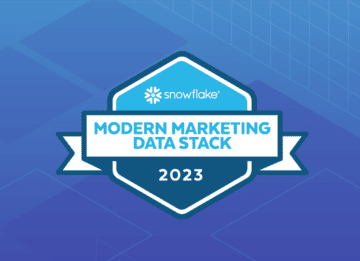
How to Respond to Third-Party Cookie & IDFA Changes
Why You Need Future-Proof Identifiers
The MarTech landscape is evolving–again. We’ve seen new legislation (GDPR, CCPA, and many more) paired with a colossal shift in changes to identifiers on consumer devices in the past few years. And we’ve seen third-party cookies disabled in Safari, Firefox, and Brave, with Google having announced they will disable third-party cookies by default in 2023.
While versions of cookie-ing and Mobile Ad IDs (MAIDs) may continue to exist, you need to consider taking a more holistic approach to adapt to these changes as smoothly as possible.
Since the market will keep evolving, you need future-proofed identifiers. First-party cookies remain essential, and direct relationships with your customers and prospects are more critical than ever. You need to be able to reach people on every channel through which they’re engaging. And you need to ensure that you’re creating a seamless experience no matter what channel, device, and browser they’re engaging on.
Persistent Identity: Your Data Strategy for the Changing Marketing Ecosystem
Identity Resolution is the answer. Instead of relying on a single identifier, Identity Resolution uses a persistent identity layer that connects multiple identifiers, such as email addresses, first-party cookies, Mobile Advertising IDs, name and physical address, etc. This creates a unified view of a person, ensuring that as your customers and prospects evolve, your method of engaging with them evolves in parallel.
Cookies and IDFAs are currently used for two things you need to solve for: Recognition and Targeting.
Thankfully, there’s a solution–by creating a persistent identity layer, you can guarantee successful recognition and targeting, even in the face of industry changes.
Why You Should Use Non-Authenticated Website Recognition
Along with changes in technology and the ever-evolving slate of privacy legislation, our expectations of brand engagement have also changed. We want a quick response time from the brands we engage. And we want transparent, personalized interactions–no matter where or how we’re reaching out.
By recognizing someone in real-time, even before they’re authenticated, you can start personalizing their experience with the content you know they want.
At FullContact, we enable non-authenticated, real-time recognition through a proprietary first-party cookie resolved to a persistent identity layer.
Our customer recognition solution empowers you to consistently recognize your customers and prospects, even before they log into your site, give you their name on a service call, or sign in to your mobile app. Identifying them at the individual level allows you to create relevant personalized messaging to create an exceptional experience.
Access to Hashed Email
With third-party cookies and Mobile Ad IDs becoming less accessible, email is becoming the most reliable method of cross-device identification. Most people have several email addresses but rarely change them, so unifying those addresses to a real-verified person will provide a long-term, reliable identity resolution capability.
Starting with a hashed email empowers you to:
- Unify various representations of a person by mapping your email lists, names and mailing addresses, phone numbers, social handles, Mobile Ad IDs, and more to create a single view of a person.
- Enrich the data you already have with additional information about the customer to get a whole person view (digital and physical), including demographics, lifestyle, purchases, and affinities.
- Access all the information you need about a customer to activate, bridge the gap between online and offline marketing, improve customer service, and create an omnichannel experience. You can activate these hashed emails on platforms such as Adobe Experience Platform / Adobe Audience Manager, many CDPs, Google Ads, Facebook, and other DMPs.
- Amplify your media reach with more points of contact, creating a higher return on ad spend.
How We Achieve Persistent Identity
Essentially, a persistent identity is mapped to a number of pieces of a person’s core identity. This process ensures that the persistent identity is maintained even if someone moves to a new address or replaces their phone number.
FullContact maintains persistent identity through our PersonID. This unique, portable, and omnichannel ID empowers you with an evolving whole-person, multidimensional view.
Having a multidimensional view of your customers will not only help your marketing but the enterprise as a whole. It will help you personalize customer experiences, create new merchandising strategies, prioritize and optimize media spend in real-time, and find more customers just like your best customers.
The Future of Personalized Customer Experiences
The bottom line is Mobile Ad IDs and third-party cookies will become increasingly difficult to use. At the same time, everything they empower you to do, i.e., recognizing website visitors and personalizing content, is only going to become more necessary. Persistency, like that created by FullContact’s PersonID, helps you circumvent volatile marketing changes.
It makes it possible for you to follow customers as they transition from channel to channel and device to device. And anchoring identity a real person, across multiple hashed email addresses, name + physical address, mobile advertising IDs and more is just the first step toward the future of marketing. Unifying the various representations of a person (emails, Mobile Ad IDs, website visits, etc.) to a persistent PersonID that can be used across the marketing ecosystem enables consistent recognition and future-proofed first-party data.
From there, you can easily unify the various representations of a person (emails, Mobile Ad IDs, website visits, etc.), enabling consistent recognition and future-proofed first-party data.
Want to future-proof your first-party data and enable real-time customer recognition? Talk to one of our experts!
Recent Blogs
-
 September 21, 2023 Discover How FullContact is Building Trusted Customer Relationships through Snowflake's Native Application Framework Customer 360, Website Recognition, Identity Resolution
September 21, 2023 Discover How FullContact is Building Trusted Customer Relationships through Snowflake's Native Application Framework Customer 360, Website Recognition, Identity Resolution -
 September 20, 2023 Transform Your Customer Experience with FullContact Customer Recognition and Boost Your Conversions Website Recognition, Identity Resolution
September 20, 2023 Transform Your Customer Experience with FullContact Customer Recognition and Boost Your Conversions Website Recognition, Identity Resolution -
 September 14, 2023 FullContact Recognized as a Leader in Snowflake’s Modern Marketing Data Stack Report FullContact News, Partnership
September 14, 2023 FullContact Recognized as a Leader in Snowflake’s Modern Marketing Data Stack Report FullContact News, Partnership